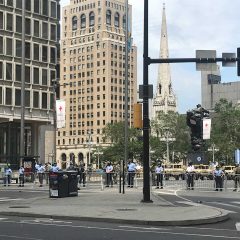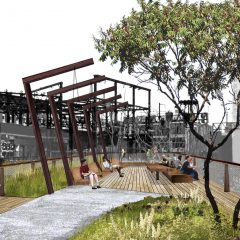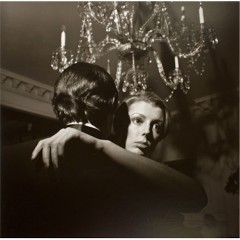[This week’s Weekly has my review of some of this Spring’s curated student shows. Here’s the link to the art page and below is the copy with some added pictures.]
School Daze
The graduate shows revealed a fascination with entrapment and vulnerability.
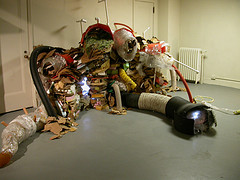
Blaine Siegel’s Gobdiddlymuck at Slought, a tour-de-force piece with humor and thoughts of society’s decay. Many of the student works seemed to be about decay.
I made it to five of the dozen or so graduating student shows in town this spring—Philadelphia Sculptors’ “Five Into One” at Moore College of Art & Design, “Voxumenta” at Vox Populi, Penn’s M.F.A. show at the Icebox Project Space, Fuel‘s inaugural show and Slought‘s “The Day After.”
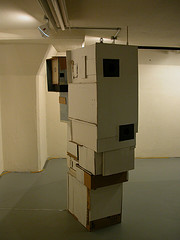
Amy Walsh, exterior of one of her cardboard boxes with elaborate architectural models inside at Slought’s Day After
They confirmed what everyone who’s been watching student shows knows: Curators can do wonders. By organizing, editing and helping hang and frame the show, curators create cohesive aesthetic events—real group shows—that are very much worth seeing.
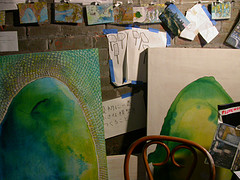
Tadashi Moriyama’s cave-like installation, detail, at the Icebox
Using these shows to read the tealeaves on the next generation is like trying to understand a Fellini film without the subtitles—but here goes. From my small sample (60-some artists), what seems to pulse in the blood of young artists right now are thoughts about being boxed in and feelings of vulnerability of their bodies. Video animation is very hot; performance video is making a comeback; cardboard constructions—either super-glued or screwed together—are of the moment, as are drawings from memory and personal reflection.
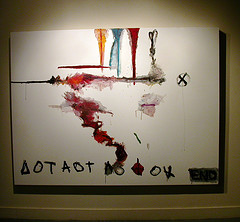
Max Maddox, large abstract painting at Slought.
The big surprise is that large-scale abstract painting is still popular. I get the abstract part, because some artists’ minds will always click with it. I don’t understand the scale. Who has wall space for a painting that’s 88 by 144 inches?
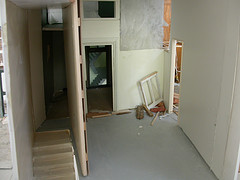
Amy Walsh, detail of interior space at 5 into 1
Boxes abound in these shows. Amy Walsh makes tabletop cardboard houses of exquisite detail and finesse. With humble exteriors and amazing labyrinthine interiors, Walsh’s buildings (see several at Slought, up through July 10) seem to reflect a world of secrets and decay. Tadashi Moriyama made a poignant cave installation at the Icebox that was wallpapered with drawings about displacement and evoked embattlement and entrapment.

Sinae Lee, the bride, inside the monitor and on top of the mail order bride box.
Sinae Lee created several video performances of herself in a box. She was caged like a prisoner in one at the Icebox, and a mail order bride living in a box in another at Moore. Phillip Adams‘ video at the Icebox showed a man with a box over his head sitting on a chair playing a banjo.
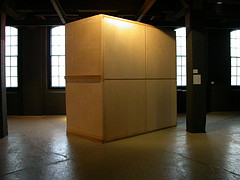
Brent Wahl’s video viewing box at the Icebox. The video in the box was a melange of imagery about boxes — hovering over water, being moved by crowds…it was quite space-y and I enjoyed it.
Brent Wahl made a walk-in video-viewing box at the Icebox that the viewer had to enter to partake of the piece. The caging of the viewer in the space is itself a comment on video art (which most viewers flee, afraid to be stuck in front of an artwork that takes longer than six seconds to digest).

Blaine Siegel’s Gobdiddlymuck. This is one end of the piece, which crawls around a corner of the room. Two short undulating green “feelers” made out of plastic pipe move slowly back and forth. The movement is charming and a little hypnotic and takes the piece to a level of pet dragon–something alive and possibly friendly. It’s wagging its tails.)
Blaine Siegel‘s Gobdiddlymuck at Slought is the work I loved best in all the shows (top image is one shot of it and above is detail.) . A low-tech dragon made of accumulated cardboard and plastic piping with intestines visible through video monitors embedded in its hulking shape, this big thug looks like a trash heap but speaks metaphorically of the cultural, ecological, bodily and political dead end these students see on the horizon. While there was humor in the piece—and some of the other students’ works—mostly there was resignation and acceptance of the lumpy, imperfect box that is life today.
“The Day After”
Through July 10. Slought Foundation, 4017 Walnut St. 215.222.9050.


